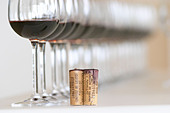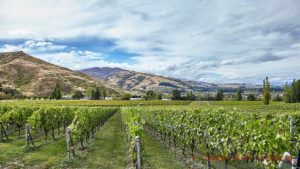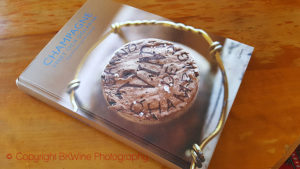 The Union des Grands Crus (UGC) in Bordeaux recently presented the 2007 vintage in Paris. the UGC includes not only the 1855 Grands Crus Classés but also some excellent producers inn Pomerol, Graves, Médoc and Saint Emilion. It can be quite a chore to taste a large number of young Bordeaux wines but this time it was quite pleasant. 2007 is a year with soft tanning and many of the wines are virtually ready to drink already today. The summer was cool with quite a lot of rain but the vintage was ‘saved’ by a nice autumn and harvest season. However, you had to be careful with the extraction, or risk getting too much green and bitter notes in the wine. Most producers choose to make a wine playing on the fruit. The best have done careful extractions and have avoided too much new oak. The result is a very good wine, approachable and with a very nice fruit dominated by blackcurrant notes and a touch of mint.
The Union des Grands Crus (UGC) in Bordeaux recently presented the 2007 vintage in Paris. the UGC includes not only the 1855 Grands Crus Classés but also some excellent producers inn Pomerol, Graves, Médoc and Saint Emilion. It can be quite a chore to taste a large number of young Bordeaux wines but this time it was quite pleasant. 2007 is a year with soft tanning and many of the wines are virtually ready to drink already today. The summer was cool with quite a lot of rain but the vintage was ‘saved’ by a nice autumn and harvest season. However, you had to be careful with the extraction, or risk getting too much green and bitter notes in the wine. Most producers choose to make a wine playing on the fruit. The best have done careful extractions and have avoided too much new oak. The result is a very good wine, approachable and with a very nice fruit dominated by blackcurrant notes and a touch of mint.
2007 is a vintage that restaurateurs will love. Ready to drink young, not needing long cellaring. This, no doubt, will benefit the consumer too in offering less expensive wines accessible now. “It’s good to have a vintage like 2007 every once in a while”, says Caroline Poniatowski at Château Lafon-Rochet in Saint Estèphe. Gonzague Lurton at Château Durfort-Vivens in Margaux thinks that they can age for 10 to 12 years: “2007 is not a vintage to lay down for very long”, he says. A “vin de plaisir” is how Eric d’Aramon at Château de Figeac describes it, to drink before the 2005s and 2006s: ”What’s important for the 2007s is to keep the fruit and the freshness”, he says. Tristan Kressmann at Chateau Latour Martillac in Pessac-Léognan sees it as an ‘in-between’ year: Cabernet sauvignon was successful thanks to good weather in October but the merlots suffered from the humidity earlier in the season. That’s why we use two thirds cabernet in the blend which is more than what we normally have. But it gives us both elegance and fruit”. Château Lagrange in Saint Julien is another winery that used more cabernet than normally and in their case it has given the wines a good structure and, thanks to soft extractions, a fresh fruit. The wine is nice, soft and agreeable.
 Antonio Flores, chef de culture at Château Malescasse in Haut-Medoc, is quite satisfied with the result. “But”, he says, “it was difficult to get sufficient ripening of the grapes. We had to do a lot of work in the vineyard and a strict sorting of the grapes when they arrived at the chai before the fermentation”.
Antonio Flores, chef de culture at Château Malescasse in Haut-Medoc, is quite satisfied with the result. “But”, he says, “it was difficult to get sufficient ripening of the grapes. We had to do a lot of work in the vineyard and a strict sorting of the grapes when they arrived at the chai before the fermentation”.
Many chateaux choose to use less new oak than habitually in 2007. Frédéric Le Clerc at Château La Tour de By in northern Médoc used only 10%. “You had to be careful not to mask the fruit”, he says.
Some other of my favourites: Cos Laboury, Saint Estèphe, with hints of aniseed, blackcurrants and a round and soft body; Grand Puy Ducasse in Pauillac, complex with a bit of astringency, needing a few more years of bottle age; Haut-Batailly and Lynch Moussas, both in Pauillac and both with lots of finesse and a fabulous fruit.
If 2007 was a non-exceptional year for the reds it was, on the contrary, a fantastic year for the whites from Pessac-Léognans (the region which was on tasting). The white Château Latour-Martillac had exceptional balance between the aromatic side of the sauvignon blanc and sémillon’s “fat”. “We don’t use more than 1/3 now oak. There should be just a hint of oak”, says Tristan Kressmann. Some other very good whites I tasted came from La Louvière, Larrivet-Haut-Brion, Ch La France, Carbonnieux and Pape-Clément (the latter with quite a lot of new oak though!).








